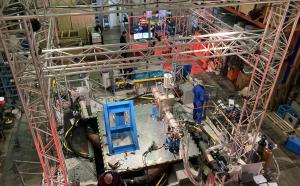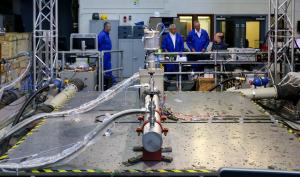Shake, rattle, and... qualify!
A public-private testing partnership certified that ITER's vacuum components can withstand major seismic events.
Making sure the ITER tokamak will be safe in the event of an earthquake means components such as flanges, pumps, and valves for the vacuum system must meet exacting design standards and undergo extensive analysis using computer modelling. And once all that is done?
"Then we get to shake the bejeebers out of things," says Eamonn Quinn, the Vacuum Mechanical Engineer at ITER who oversees the security of the components.
Seismic testing is a crucial step in the construction of a nuclear facility but at ITER it takes on special importance because there are so many first-of-kind components and the safety standards being developed will likely inform future fusion regulations.
The vacuum team at ITER is currently qualifying more than 70 different types of metal valves to ensure they remain secure during an earthquake. While nuclear fusion doesn't carry the same risk of a runaway reaction as a traditional fission reactor, a valve still needs to function during crisis situations to prevent tritium or other matter from escaping the tokamak. This means valves go through high-intensity simulations on shaker tables to guarantee they close or open correctly and continue to serve as a confinement barrier during a seismic event.
"The qualification process is sensitive because earthquake conditions need to be replicated, which means recreating the precise vibrations, heat, and mechanical load that's expected in the particular location the component is going to be used," explains Eamonn. "The lead-up to one test can be many months; it's a mammoth task."
Part of this mammoth task was facilitated by a public-private partnership that ITER formed with Element, which is one of the world leaders for testing and certification, and the University of Bristol, which has one of the larger shaker table facilities in Europe.
Much of the testing done by Element involves the aeronautics sector and simulating fight conditions for parts that will be used in airplanes. However, the company also does a wide range of other testing, such as recreating desert environments to see how machines resist dust storms or simulating cold and vibrations to check if pregnancy tests can handle low-temperature transport. It was precisely this type of flexibility that made a success of the partnership between ITER and Element because they were able to reliably recreate the conditions the valve would face in the Tokamak Building.
But before the valves found their way to a seismic shaking table in Bristol, they went through a rigorous testing process. First, the representative sample of the valves produced by the manufacturer VAT went through operational and vacuum testing before being shipped. Once at ITER, valve cycling and helium leak testing was conducted to make sure the valve met vacuum protocols. After this, it was transported to the University of Bristol, where Element has an agreement to rent time on the university's shaker tables—allowing doctoral students to gain real-world engineering experience by observing testing and certification such as that done for ITER.
ITER personnel were always on-site for the seismic testing in Bristol to provide the vacuum and tokamak expertise. Prior to each test, the team at Element programmed the three-metre-square table based on the metrics provided by ITER. Depending on where in the Tokamak Building the valve will be positioned, the valve was shaken to IEEE standards based on different possible conditions: SL-1 (light earthquake), SL-2 (medium earthquake), or SL-3 (extreme earthquakes that are far beyond any projected seismic activity in the south of France where ITER is located). While the shaking during much of the testing was similar to driving along a bumpy country road, at its peak it reached a g-force of 8g, which was equivalent to the vibrations felt by a rocket during re-entry to the Earth's atmosphere.
For each test, the valve was filled with helium and wrapped in a vacuum bag to see if structural breaches occurred during shaking that would allow the gas to escape. Then, heating blankets were added to simulate the temperature of the tokamak and a mechanical rig was used to replicate the forces that would be on the valve when it will be in use. Once all this was in place, a technician "drove" the table, which means it was shaken along three axes to create the precise ground accelerations of an earthquake.
"The tests were quite spectacular, especially for the SL-3 testing," says Graeme Vine, an ITER vacuum engineer who was involved in the testing.
When a valve passed these tests, it became qualified for use at ITER. The lead time to manufacture large valves can be as much as 15 months, which adds to the long journey from design to having a qualified component in hand.
Chris Stone, the department manager for the seismic testing at Element, has been part of valve testing for the last six years. He says the ITER work is some of the most complex testing the company has done, but it is also among the most rewarding.
"ITER is a public domain project, so there is a great philosophy of sharing information with the aim of doing the best job possible," says Chris. "And from an engineering point of view, being part of a project that has the majority of the world trying to do something that will make the whole place better, you can't get much better than that, can you?"
See what a shake experiment for ITER looks like on YouTube here.



